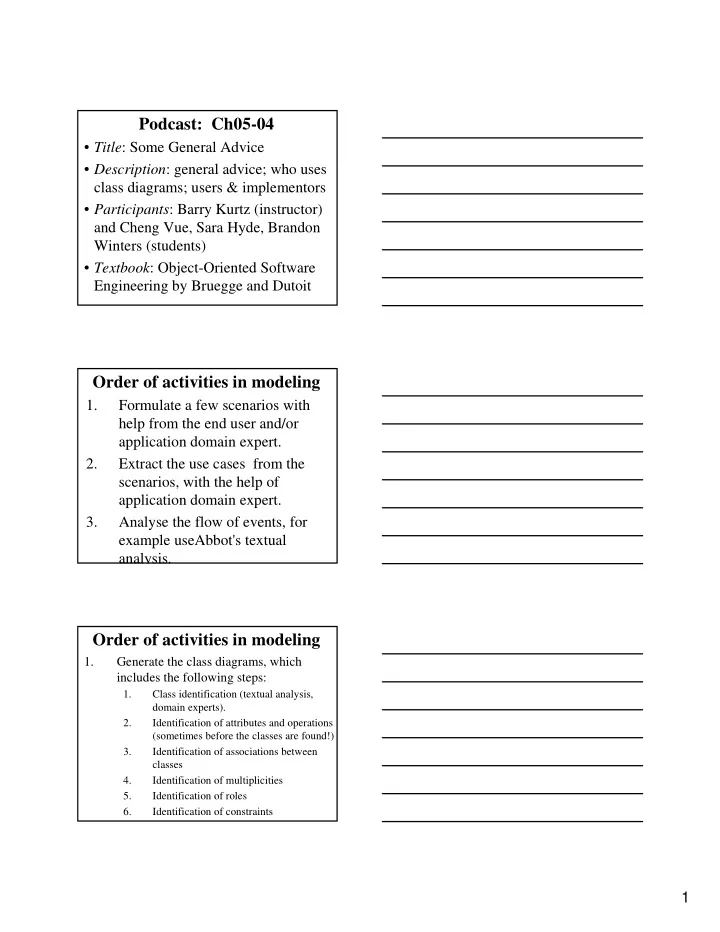

Podcast: Ch05-04 • Title : Some General Advice • Description : general advice; who uses class diagrams; users & implementors • Participants : Barry Kurtz (instructor) and Cheng Vue, Sara Hyde, Brandon Winters (students) • Textbook : Object-Oriented Software Engineering by Bruegge and Dutoit Order of activities in modeling 1. Formulate a few scenarios with help from the end user and/or application domain expert. 2. Extract the use cases from the scenarios, with the help of application domain expert. 3. Analyse the flow of events, for example useAbbot's textual analysis. Order of activities in modeling 1. Generate the class diagrams, which includes the following steps: 1. Class identification (textual analysis, domain experts). 2. Identification of attributes and operations (sometimes before the classes are found!) 3. Identification of associations between classes 4. Identification of multiplicities 5. Identification of roles 6. Identification of constraints 1
Avoid Ravioli Models Account Bank Customer * Amount * Has Name Name AccountId CustomerId AccountI d Deposit() Withdraw() CustomerId GetBalance() Savings Checking Mortgage Account Account Account Don’t put too many classes into the same package: Don’t put too many classes into the same package: 7+-2 (or even 5+-2) 7+-2 (or even 5+-2) Withdraw() Withdraw() Withdraw() Put Taxonomies on a separate Diagram Account Amount AccountId CustomerId AccountI d Deposit() Withdraw() GetBalance() Savings Checking Mortgage Account Account Account Withdraw() Withdraw() Withdraw() Project Management Heuristics • Explicitly schedule meetings for object identification • First just find objects • Then try to differentiate them between entity, interface and control objects • Find associations and their multiplicity –Unusual multiplicities usually lead to new objects or categories 2
Project Management Heuristics • Identify Inheritance: Look for a Taxonomy, Categorize • Identify Aggregation • Allow time for brainstorming , Iterate, iterate, iterate, … Who uses class diagrams? • Purpose of Class diagrams : –The description of the static properties of a system (main purpose) • Who uses class diagrams? • The customer and the end user are often not interested in class diagrams. They usually focus more on the functionality of the system. Who uses class diagrams? • The application domain expert uses class diagrams to model the application domain • The developer uses class diagrams during the development of a system,that is, during analysis, system design, object design and implementation. 3
Different types of users • According to the development activity, the developer plays different roles. – Analyst – System-Designer, – DetailedDesigner – Implementor . • In small systems some of the roles do not exist or are played by the same person. Different types of users • Each of these roles has a different view about the models. • Before describing these different views, we need to distinguish the types of classes that appear in class diagrams. –Application domain classes –Solution domain classes Application Domain • Application domain: –The problem domain (financial services, meteorology, accident management, architecture, …). • Application domain class: –An abstraction in the application domain. If we model business applications, these classes are also called business objects. –Example: Board game, Tournament 4
Solution Domain • Solution domain: –Domains that help in the solution of problems (telecommunication, data bases, compiler construction, operting systems, ….) • Solution domain class: • An abstraction, that is introduced for technical reasons, because it helps in the solution of a problem. –Examples: Tree, Hashtable, Scheduler The Role of the Analyst • The analyst is interested –in application classes: The associations between classes are relationships between abstractions in the application domain. –whether the use of inheritance in the model reflect the taxonomies in the application domain. • The analyst is not interested –in the exact signature of operations. –in solution classes. Designer • The designer focuses on the solution of the problem, that is the solution domain. • Design consists of many tasks (subsystem decomposition, selection of the hardware platform, data management system, etc.). • An important design problem is the specification of interfaces 5
Designer • The designer describes the interface of classes (object design) and subsystems (system design). • The goal of the designer is usability and reusability of interface – Design-Usability: the interfaces are usable from as many classes as possible within in the system. – Design-Reusability: Definition of interfaces, such that they can also be used in other (future) software systems. => Class libraries. Three Types of Implementors • Class implementer: –Implements the class. The implementer chooses appropriate data structures (for the attributes) and algorithms (for the operations), and realizes the interface of the class ina programming language. • Class extender: –Extends the class by a subclass, which is needed for a new problem or a new application domain. Three Types of Implementors • Class user: –The programmer, who wants to use an existing class (e.g. a class from a class library or a class from another subsystem). –The class user is only interested in the Signatures of the class operations and the preconditions, under which they can be invoked. The class user is not so much interested in the implementation of the class. 6
Recommend
More recommend